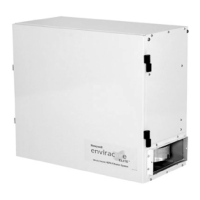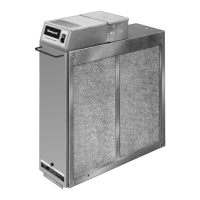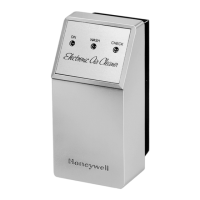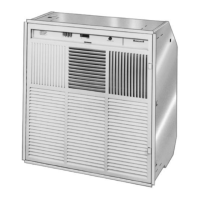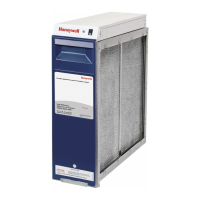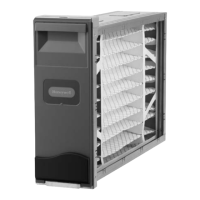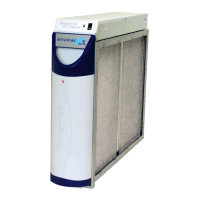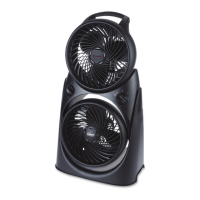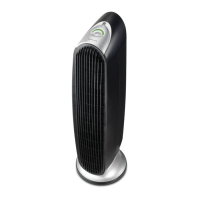13 68-0137B—2
F50F
SERVICE
Service
IMPORTANT:
• Check the dishwasher owner’s manual. Some manu-
facturers do not recommend washing electronic
cell(s) in their dishwashers.
• If the dishwasher has upper and lower arms, position
the cell(s) carefully to allow good water circulation.
• Be careful to avoid damaging the cell(s) when plac-
ing them in the dishwasher. Broken ionizer wires
or bent collector plates are not included in the
warranty.
• Very dirty cell(s), especially from tobacco or cooking
smoke, can discolor the plastic parts and the lining of
some dishwashers. This discoloration is not harmful.
To minimize it, wash the cell(s) more frequently or
try a different brand of detergent.
• Do NOT allow the dishwasher to run through the
dry cycle. This will bake on any contaminants not
removed during the wash cycle and reduce air
cleaner efficiency.
1. Put the cell(s) on the lower rack of the dishwasher
with the airflow arrow pointing up. It may be necessary to
remove the upper rack. Do not block water flow to the
upper arm.
HINT: Lay a few large water glasses between the spikes
on the lower rack, and rest the cell(s) on them so the
spikes do not damage the aluminum collector blades.
2. Using regular dishwashing detergent, allow the dish-
washer to run through the complete wash and rinse cycle.
Do not use the dry cycle. To avoid burns, let the cell(s)
cool completely before removing, or wear protective gloves
when removing the cell(s). Remember that water may be
trapped inside the cell(s). Tip the cell(s) so these tubes
can drain.
3. Wipe the ionizer wires and contact board on the end
of the cell using thumb and forefinger with a small, damp
cloth.
4. Inspect the dishwasher. Rerun the wash and/or rinse
cycle with the dishwasher empty if there is dirt or residue
from washing the cell(s). If dirt or residue seems excessive,
wash the cell(s) more often or try a different detergent.
Washing the Cell(s) in a Container
CAUTION
HAZARDOUS CHEMICAL.
CAN CAUSE PERSONAL INJURY.
• Do not splash the detergent solution in eyes.
Wear rubber gloves to avoid prolonged deter-
gent contact with skin.
• Keep detergent and solution out of reach of
children.
!
CAUTION
SHARP EDGES.
CAN CAUSE PERSONAL INJURY.
Carefully handle the cell(s) or wear protective
gloves to avoid cuts from the sharp metal edges.
CLEANING THE CELL(S) AND PREFILTER(S)
To assure optimum performance from the air cleaner,
the cell(s) and prefilter(s) must be cleaned regularly—
every one to six months. Washing frequency will vary
depending on the number of family members, pets, activi-
ties (such as cooking or woodshop) and smoking habits.
Use the wash reminder schedule provided with the air
cleaner to help establish and maintain a regular cleaning
schedule. Mount the wash reminder schedule in a conve-
nient location.
If the air cleaner has a W8600E indicator, the WASH
LED will light to indicate that a cell and prefilter washing
is past due. When the WASH LED comes on, it means
that the cell(s) is loaded with dirt to the extent that air
cleaning efficiency is diminished. Plan to wash the cell(s)
and prefilter(s) as soon as possible. But by using the wash
reminder schedule, washing can be established so that the
cell(s) are clean enough so the WASH LED does not come
on.
If you find that the WASH LED is coming on more
frequently than the established schedule, there maybe a
buildup of residue on the ionizer wires. If the collector
plates on the cell(s) look clean, try wiping the ionizer wires
with a clean cloth instead of washing the entire cell.
Also consider whether some activity in the home has
changed, causing the cell(s) to become dirty faster. Have
the windows been open more often? Has someone been
smoking more often? Has someone taken up woodworking
or some other hobby that creates dust?
NOTE: To let the heating or air conditioning system oper-
ate normally while the cell(s) are being washed. Simply
turn off the air cleaner switch.
Vacuum the prefilter or brush, or soak it in a tub. Do not
wash the prefilter in the dishwasher or car wash.
Automatic Dishwasher
CAUTION
BURN HAZARD.
CAN CAUSE PERSONAL INJURY.
Allow the cell(s) to cool completely in the dish-
washer at the end of the wash cycle or wear
protective gloves to avoid burns. Hot water can
accumulate in the tubes supporting the collector
plates. Tip the cell(s) so the tubes will drain.
!
!
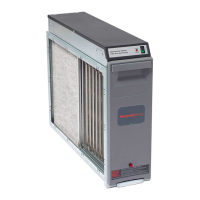
